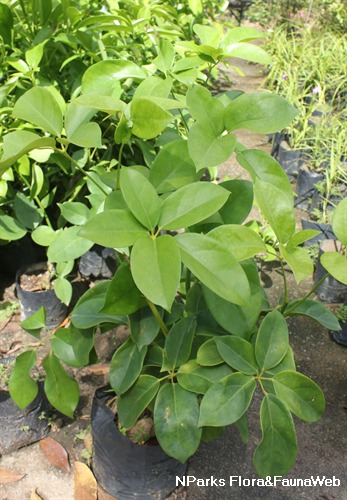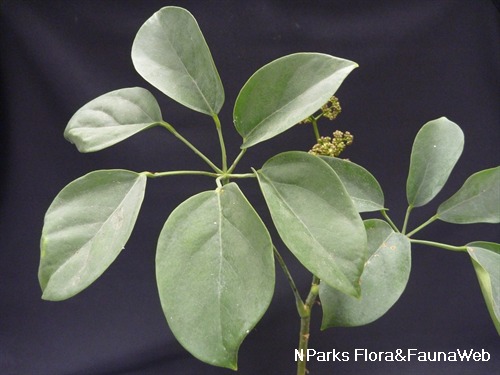
Back
Heptapleurum ellipticum (Blume) Seem.
| Family Name: | Araliaceae |
| Synonyms: | Schefflera elliptica (Blume) Harms |
| Common Name: | Ara Bebari, Bunga Kuku Langsuir, Cenama Gajah, 密脉鹅掌柴 |
Name
Classifications and Characteristics
| Plant Division | Angiosperms (Flowering Seed Plants) (Dicotyledon) |
|---|---|
| Plant Growth Form | Climber, Shrub |
| Lifespan (in Singapore) | Perennial |
| Mode of Nutrition | Autotrophic |
| Plant Shape | Irregular |
| Maximum Height | 10 m |
Biogeography
| Native Distribution | From southern China, throughout Southeast Asia (including Singapore), to Christmas Island, Mismarck Archipelago, and northern Australia. |
|---|---|
| Native Habitat | Shoreline (Mangrove Forest), Terrestrial (Grassland / Savannah/ Scrubland, Riverine, Coastal Forest, Secondary Rainforest, Mountain, Primary Rainforest) |
| Preferred Climate Zone | Tropical, Sub-Tropical / Monsoonal |
| Local Conservation Status | Native to Singapore (Endangered (EN)) |
Description and Ethnobotany
| Growth Form | It is a woody climber or straggling shrub, up to 10 m tall. |
|---|---|
| Foliage | Its alternate, stalked, palmate leaves have 4-7 leaflets that are 6-18 by 2.5-10 cm. |
| Flowers | Its greenish flowers are arranged in a 10-flowered cluster. |
| Fruit | Its fruits are round to egg-shaped, ripening from yellow or orange to black. |
| Habitat | It grows in lowland and hill forests or scrub, limestone hills, mangrove forests or scrub, limestone hills, mangrove and secondary forests up to 2,500 m altitude. It also grows along coasts and rivers. |
| Associated Fauna | Its flowers are pollinated by insects and the fruits are eaten by birds. |
| Cultivation | It can be propagated from seed or stem cuttings. |
| Etymology | Latin Schefflera, commemorating Jakob Scheffler, a physician in Poland; Latin elliptica, elliptic, referring to the shape of the leaflets. |
| Ethnobotanical Uses | Medicinal: It has several medicinal uses including treatment for coughs, edema, toothache, and wounds, and for prevention of scurvy. |
Landscaping Features
| Landscaping | It is suitable for growing along roadsides, parks and gardens as a shrub. |
|---|---|
| Desirable Plant Features | Ornamental Foliage |
| Landscape Uses | General, Suitable for Roadsides, Parks & Gardens, Small Gardens, Coastal, Beachfront / Shoreline, Riverine, Flowerbed / Border |
Fauna, Pollination and Dispersal
| Fauna Pollination Dispersal Associated Fauna | Bird-Attracting |
|---|---|
| Pollination Method(s) | Biotic (Fauna) |
| Seed or Spore Dispersal | Biotic (Fauna) |
Plant Care and Propagation
| Light Preference | Full Sun, Semi-Shade |
|---|---|
| Water Preference | Lots of Water, Moderate Water |
| Plant Growth Rate | Moderate |
| Rootzone Tolerance | Moist Soils, Well-Drained Soils, Saline Soils / Salt Spray, Fertile Loamy Soils |
| Transplanting Tolerance | Good |
| Maintenance Requirements | Moderate |
| Propagation Method | Seed, Stem Cutting |
Foliar
| Foliage Retention | Evergreen |
|---|---|
| Mature Foliage Colour(s) | Green |
| Mature Foliage Texture(s) | Leathery |
| Foliar Type | Compound (Palmate) |
| Foliar Arrangement Along Stem | Alternate |
| Foliar Attachment to Stem | Petiolate |
| Foliar Shape(s) | Non-Palm Foliage (Ovate, Oval, Elliptical) |
| Foliar Venation | Pinnate / Net |
| Foliar Margin | Entire |
Floral (Angiosperm)
| Flower & Plant Sexuality | Bisexual Flowers |
| Flower Colour(s) | Green |
|---|---|
| Flower Grouping | Cluster / Inflorescence |
| Flower Location | Axillary |
| Inflorescence Type | Compound Umbel |
Fruit, Seed and Spore
| Mature Fruit Colour(s) | Black, Orange, Yellow / Golden |
|---|---|
| Fruit Classification | Simple Fruit |
| Fruit Type | Fleshy Fruit , Non-Accessory Fruit |
Image Repository
Others
| Master ID | 31719 |
|---|---|
| Species ID | 6118 |
| Flora Disclaimer | The information in this website has been compiled from reliable sources, such as reference works on medicinal plants. It is not a substitute for medical advice or treatment and NParks does not purport to provide any medical advice. Readers should always consult his/her physician before using or consuming a plant for medicinal purposes. |







